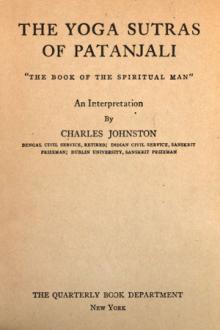An Introduction to Yoga, Annie Besant [good books to read for 12 year olds .txt] 📗

- Author: Annie Besant
- Performer: 8170590507
Book online «An Introduction to Yoga, Annie Besant [good books to read for 12 year olds .txt] 📗». Author Annie Besant
Sometimes for a special purpose seclusion may be useful. It may be well at times to retire temporarily from the busy haunts of men. But in the universe planned by Isvara, in order that the powers of the Self may be brought outÄthere is your best field for Yoga, planned with Divine wisdom and sagacity. The world is meant for the unfolding of the Self: why should you then seek to run away from it? Look at Shri Krishna Himself in that great Upanishad of yoga, the Bhagavad-Gita. He spoke it out on a battle-field, and not on a mountain peak. He spoke it to a Kshattriya ready to fight, and not to a Brahmana quietly retired from the world. The Kurukshetra of the world is the field of Yoga. They who cannot face the world have not the strength to face the difficulties of Yoga practice. If the outer world out-wearies your powers, how do you expect to conquer the difficulties of the inner life? If you cannot climb over the little troubles of the world, how can you hope to climb over the difficulties that a yogi has to scale? Those men blunder, who think that running away from the world is the road to victory, and that peace can be found only in certain localities.
As a matter of fact, you have practised Yoga unconsciously in the past, even before your self-consciousness had separated itself, was aware of itself. Sand knew itself to be different, in temporary matter at least, from all the others that surround it.
And that is the first idea that you should take up and hold firmly: Yoga is only a quickened process of the ordinary unfolding of consciousness.
Yoga may then be defined as the “rational application of the laws of the unfolding of consciousness in an individual case”. That is what is meant by the methods of Yoga. You study the laws’ of the unfolding of consciousness in the universe, you then apply them to a special caseÄand that case is your own. You cannot apply them to another. They must be self-applied. That is the definite principle to grasp. So we must add one more word to our definition: “Yoga is the rational application of the laws of the unfolding of consciousness, self-applied in an individual case.”
Yoga Is a Science
Next, Yoga is a science. That is the second thing to grasp. Yoga is a science, and not a vague, dreamy drifting or imagining. It is an applied science, a systematized collection of laws applied to bring about a definite end. It takes up the laws of psychology, applicable to the unfolding of the whole consciousness of man on every plane, in every world, and applies those rationally in a particular case. This rational application of the laws of unfolding consciousness acts exactly on the same principles that you see applied around you every day in other departments of science.
You know, by looking at the world around you, how enormously the intelligence of man, co-operating with nature, may quicken “natural” processes, and the working of intelligence is as “natural” as anything else. We make this distinction, and practically it is a real one, between “rational” and “natural”
growth, because human intelligence can guide the working of natural laws; and when we come to deal with Yoga, we are in the same department of applied science as, let us say, is the scientific farmer or gardener, when he applies the natural laws of selection to breeding. The farmer or gardener cannot transcend the laws of nature, nor can he work against them. He has no other laws of nature to work with save universal laws by which nature is evolving forms around us, and yet he does in a few years what nature takes, perhaps, hundreds of thousands of years to do. And how? By applying human intelligence to choose the laws that serve him and to neutralize the laws that hinder. He brings the divine intelligence in man to utilise the divine powers in nature that are working for general rather than for particular ends.
Take the breeder of pigeons. Out of the blue rock pigeon he develops the pouter or the fan-tail; he chooses out, generation after generation, the forms that show most strongly the peculiarity that he wishes to develop. He mates such birds together, takes every favouring circumstance into consideration and selects again and again, and so on and on, till the peculiarity that he wants to establish has become a well-marked feature. Remove his controlling intelligence, leave the birds to themselves, and they revert to the ancestral type.
Or take the case of the gardener. Out of the wild rose of the hedge has been evolved every rose of the garden. Many-petalled roses are but the result of the scientific culture of the five-petalled rose of the hedgerow, the wild product of nature. A gardener who chooses the pollen from one plant and places it on the carpers of another is simply doing deliberately what is done every day by the bee and the fly. But he chooses his plants, and he chooses those that have the qualities he wants intensified, and from those again he chooses those that show the desired qualities still more clearly, until he has produced a flower so different from the original stock that only by tracing it back can you tell the stock whence it sprang.
So is it in the application of the laws of psychology that we call Yoga. Systematized knowledge of the unfolding of consciousness applied to the individualized Self, that is Yoga.
As I have just said, it is by the world that consciousness has been unfolded, and the world is admirably planned by the LOGOS
for this unfolding of consciousness; hence the would-be yogi, choosing out his objects and applying his laws, finds in the world exactly the things he wants to make his practice of Yoga real, a vital thing, a quickening process for the knowledge of the Self. There are many laws. You can choose those which you require, you can evade those you do not require, you can utilize those you need, and thus you can bring about the result that nature, without that application of human intelligence, cannot so swiftly effect.
Take it, then, that Yoga is within your reach, with your powers, and that even some of the lower practices of Yoga, some of the simpler applications of the laws of the unfolding of consciousness to yourself, will benefit you in this world as well as in all others. For you are really merely quickening your growth, your unfolding, taking advantage of the powers nature puts within your hands, and deliberately eliminating the conditions which would not help you in your work, but rather hinder your march forward. If you see it in that light, it seems to me that Yoga will be to you a far more real, practical thing, than it is when you merely read some fragments about it taken from Sanskrit books, and often mistranslated into English, and you will begin to feel that to be a yogi is not necessarily a thing for a life far off, an incarnation far removed from the present one.
Man a Duality
Some of the terms used in Yoga are necessarily to be known. For Yoga takes man for a special purpose and studies him for a special end and, therefore, only troubles itself about two great facts regarding man, mind and body. First, he is a unit, a unit of consciousness. That is a point to be definitely grasped. There is only one of him in each set of envelopes, and sometimes the Theosophist has to revise his ideas about man when he begins this practical line. Theosophy quite usefully and rightly, for the understanding of the human constitution, divides man into many parts and pieces. We talk of physical, astral, mental, etc. Or we talk about Sthula-sarira, Sukshma-sarira, Karana-sarira, and so on. Sometimes we divide man into Anna-maya-kosa, Prana-maya-kosa, Mano-maya-kosa, etc. We divide man into so many pieces in order to study him thoroughly, that we can hardly find the man because of the pieces. This is, so to say, for the study of human anatomy and physiology.
But Yoga is practical and psychological. I am not complaining of the various subdivisions of other systems. They are necessary for the purpose of those systems. But Yoga, for its practical purposes, considers man simply as a dualityÄmind and body, a unit of consciousness in a set of envelopes. This is not the duality of the Self and the Not-Self. For in Yoga, “Self” includes consciousness plus such matter as it cannot distinguish from itself, and Not-Self is only the matter it can put aside.
Man is not pure Self, pure consciousness, Samvid. That is an abstraction. In the concrete universe there are always the Self and His sheaths, however tenuous the latter may be, so that a unit of consciousness is inseparable from matter, and a Jivatma, or Monad, is invariably consciousness plus matter.
In order that this may come out clearly, two terms are used in Yoga as constituting manÄPrana and Pradhana, life-breath and matter. Prana is not only the life-breath of the body, but the totality of the life forces of the universe or, in other words, the life-side of the universe.
“I am Prana,” says Indra. Prana here means the totality of the life-forces. They are taken as consciousness, mind. Pradhana is the term used for matter. Body, or the opposite of mind, means for the yogi in practice so much of the appropriated matter of the outer world as he is able to put away from himself, to distinguish from his own consciousness.
This division is very significant and useful, if you can catch clearly hold of the root idea. Of course, looking at the thing from beginning to end, you will see Prana, the great Life, the great Self, always present in all, and you will see the envelopes, the bodies, the sheaths, present at the different stages, taking different forms; but from the standpoint of yogic practice, that is called Prana, or Self, with which the man identifies himself for the time, including every sheath of matter from which the man is unable to separate himself in consciousness. That unit, to the yogi, is the Self, so that it is a changing quantity. As he drops off one sheath after another and says: ” That is not myself,” he is coming nearer and nearer to his highest point, to consciousness in a single film, in a single atom of matter, a Monad. For all practical purposes of Yoga, the man, the working, conscious man, is so much of him as he cannot separate from the matter enclosing him, or with which he is connected. Only that is body which the man is able to put aside and say: “This is not I, but mine.” We find we have a whole series of terms in Yoga which may be repeated over and over again. All the states of mind exist on every plane, says Vyasa, and this way of dealing with man enables the same significant words, as we shall see in a moment, to be used over and over again, with an ever subtler connotation; they all become relative, and are equally true at each stage of evolution.
Now it is quite clear that, so far as many of us are concerned, the physical body is the only thing of





Comments (0)